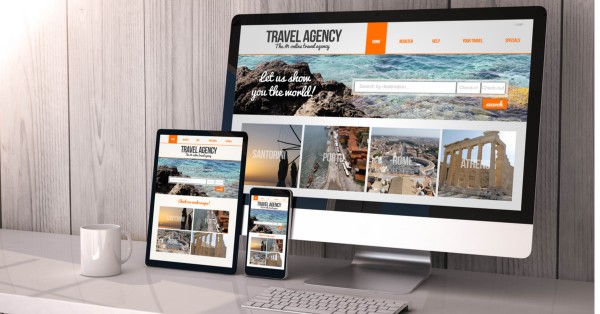18 Things Everyone Must Know Before Launching a Website
The Top 18 Things You Need to Check Before Launching a Website
After weeks of designing, writing, and developing, the time has come to finally launch the website! It’s an exciting day, but for DIY and corporate digital marketers, the hours before launch are filled with nerves. Before you press publish, invest the time to double-check the design, SEO, back-end details, and user experience of website.

1. Does your website have uniform font stylings?
Typography is one of the most overlooked features of a website. Ensure you’ve chosen a style of font that connects with the voice of your brand. Otherwise, your website will come across as unprofessional.
Typography needs to maintain its consistency throughout your entire website. Remember, bold and italics have power. Look at your headers and subtitles and make sure each page follows the same hierarchical structure of bold, italics, and regular text for H1, H2, and H3. Your website’s body text should be the same font and size throughout.
2. Is the legibility of text clear on both color and image backgrounds?
What’s the point in having text on your website if users can’t read it? Your website’s color scheme needs to make your text come alive. Avoid cluttered images, check your contrast ratio, and let the text shine.
3. Is the layout of your website’s navigation easy for readers?
A website with no navigational order is like opening a restaurant menu with pages of food and no titles. You’ll know you’ve properly organized the navigational flow of your website if you’ve accurately anticipated your customer’s needs. What questions do they ask most often? They shouldn’t have to look far to contact you or wonder where to find your products and forms.
If you have a lot of headers in your navigation bar, use the main heading and provide a list with sub-headers in the navigation menu. Fill your footer with hyperlinks, a contact form, socials, and business information. Calgary web design agencies know how to streamline your company’s needs with current and future client desires when designing website layouts.
Although we’d like to hope that users who visit our website spend the five minutes it takes to browse and read it in its entirety, that certainly is not the reality. Your website should be as user-friendly for the reader as it is for the scanner. Allow easy scanning navigation by utilizing bold header and icons to break up long explanations.
4. Do you have a uniform color palette throughout your website?
Utilize colour to evoke emotion and inspire customer bonds the moment users click on your website. Acquaint yourself with the psychology of colour and implied meanings. Your website’s color palette should have a purpose, align with the feeling of your brand and be consistent across your website. Additionally, keep an eye on what’s trendy for the season, as colors in fashion change in tandem with industries like fashion. For example, pastels were trendy in 2020 but more natural tones are in style as of 2021. Our Calgary graphic designers recommend having light and dark primary colors chosen, with 2-3 accents to enhance your website and create a timeless brand.
5. Are your images website optimized?
Web-optimized images should be about 72 DPI. Any images above this will result in high loading speeds while images that fall under 72 DPI will result in low resolution. Image optimization will greatly improve your loading speed and boost your SEO ranking. Our design and marketing agency recommends using ImageOptim for image optimization and icons8 for image upscale.
6. Have you checked and double-checked your copy’s grammar and spelling?
You’ve come this close to launching your website – you don’t want a simple and embarrassing grammar mistake to flout your efforts. If you’re the only one launching the website, proofread your website one type of grammatical error at a time. Saying the copy out loud will help correct punctuation. No sentence should take more than one breath to read. Team up if you can as fresh eyes catch mistakes invisible to you.
7. Is your website content written for your audience?
Copy for your website needs to exude the tone of your brand while speaking to the needs, wants and desires of your target audience. Icons should not be followed with more than one long or two short sentences and paragraphs should be no more than 3-4 sentences. You don’t want your website to sound like a sales pitch and you need to differentiate your brand as a thought leader with an innovative perspective. To add to the list of things a few sentences must achieve, you need to include SEO. If your website’s copy does not meet these outcomes, it’s time to invest in your ROI and hire a website copywriter.
8. Have you included the right keyword to maximize your website’s SEO?
Using Google’s Keyword Ad Planner, type in the keywords for your website. Your keywords should include your company’s name, type of service or product with attachment to your city, province, NE, NW, SW, or SE. Google’s Keyword Ad Planner will show you if your chosen keywords receive search traffic. Differentiate between medium, high and low traffic keywords.
Check how much traffic keywords receive – some low-ranking keywords can receive up to 100k/month in traffic. For small businesses, this is their goal. Your SEO keywords should be embedded smoothly into your website’s copy. Remember, SEO is important, but the user experience is your website’s priority.
9. Do all the buttons and links work on your website?
There’s nothing more disappointing to a user and to you than clicking on a link or button and being unable to follow through on a high-potential conversion. Underneath the design and copy of a website are layers of accessibility. Our Calgary web designers utilize UX design strategies that save you time and the headache of broken links and lost business. Don’t underestimate the need to manually go through and just double-check every link goes to where you expect, so as to not disrupt the customers’ journey.
10. Are you connected to Google Analytics to receive website statistics?
Websites can always be improved upon. Google Analytics provides essential information to track the progress of your website. Set up a reporting account and add the tracking code to your website. Information recorded includes a user’s: time of visit, pages visited, time spent on each page, type of operating system/web browser, network location, IP address, referring site details, screen resolution, flash version and JavaScript support. Don’t forget to set up a Google tracking ID on every webpage. Your tracking ID allows Google Analytics to identify your website and streamline accurate user information.
11. Does your website contain Facebook Pixel to run ads?
Facebook Pixel is an analytic tool that tracks user decisions from Facebook marketing campaigns to your website. Implementing this tool is a smart strategy to evaluate your marketing and refine your target market. It allows you to set goals for future campaigns and evaluate conversion. Websites require continuous improvement in order to reach goals effectively.
12. Are your form entries sent and received to the correct email addresses?
This may seem obvious, but you can never be too careful. Form entries provide a lot of business and should be sent to a company email address. Is the staff member that can address the particular inquiry receiving the messages? Should it be sent to multiple people? Ensure your form offers a convenient experience for users, providing their reasons for contact through lists and checkboxes.
13. Have you made your website tablet-friendly?
Laptops will never be outdated, but tablets are catching up in functionality, power and are surpassing them in portability. Remember to optimize your website for vertical and horizontal viewing angles. Buttons should be large and easy to find. Users shouldn’t have to zoom in to read the text and your pages shouldn’t overdo it on scrolling.
14. Is your website responsive for mobile devices?
Mobile devices are a part of everyday life and when optimized correctly, provide a convenient and enjoyable experience for your customers. Test your website on Google’s mobile-friendly tool. When our Calgary web designers develop a website, we include responsive design. This allows us to use the same content, arrange the text to the size of screen, and reap the same SEO benefits as desktop sites. Make sure your elements stack properly and that all of your web pages follow thetag. The viewport meta tag uses responsive design and tells your browser how to arrange your text to the size of screen used.
15. Have you checked to see if a 404 page error exists?
If you had an old website and the URL changed, users will be confronted with a 404 error page if they click on an old link. Set up a redirect to the new page if the information still exists and stay vigilant on possible error pages in the weeks following your websites’ launch. Avoid server errors with the help of a website developer.
16. Are your titles and descriptions optimized for SEO?
Your website’s page title and meta descriptions are two of the most important SEO features to help your website rank higher on Google and be located by users. Meta descriptions are short summaries of your website pages and should be around 160 characters and if possible, unique to every page. Including a call-to-action in your meta description will help Google crawl and recognize the content as users search. Title tags should be 55-60 characters long. Include your company’s name, location, title of the page and target keywords.
17. Does your featured image have the desired impact?
The featured image is the preview page that shows up when you link your website on social accounts. Avoid using generic stock photos and choose a high-quality image or graphic that represents your entire website. The image should land around 1200×628 pixels to avoid anything being cropped. The featured image is one of the best opportunities you have to customize your brand through an authentic picture. Web designers know how to design and select the image that will drive the most conversions to your website.
18. Have you migrated your website domain to new email addresses?
A common mistake is migrating a website domain that already has emails attached to it. Forgetting to enter the same record or pointing the hosting away might break an email server, which can be detrimental for a company. If it’s a new website, make sure you have business emails being set up if needed.
The tasks from website inception-launch fall on your shoulders as the last line of defense. Use this checklist, and it’ll become your special weapon to ensure your hard work pays off. If you’d rather avoid this checklist altogether, saving time while creating a website that delivers exceptional results, our Calgary web design agency uses this checklist – and more – before launching our clients’ websites.
Media Contact
Company Name: JYZ Design
Contact Person: Judy Yu
Email: Send Email
Phone: 403-453-2990
Address:917 9 Ave SE, Suite 205
City: Calgary
State: AB, T2G 0S5
Country: Canada
Website: https://jyzdesign.com


